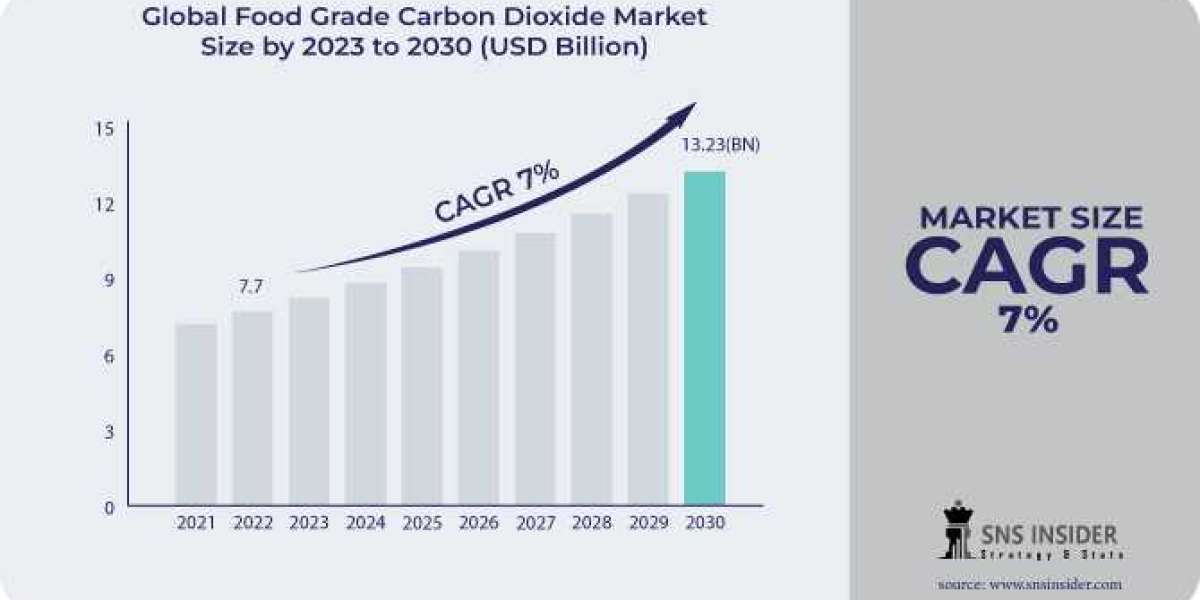Market Overview
Food grade carbon dioxide (CO₂) is a crucial component in various food and beverage applications, ensuring quality, safety, and efficiency in production and preservation processes. It is used in applications such as carbonation of beverages, freezing and chilling of food products, and modified atmosphere packaging (MAP). The demand for food grade CO₂ has been bolstered by the growing global consumption of processed and packaged foods, as well as increasing trends toward carbonated beverages.
Key Market Segmentation
The Food Grade Carbon Dioxide Market is segmented by type, industry, mode of supply, application, and region.
By Type
- Solid (Dry Ice): Used primarily for freezing and chilling applications in the food industry.
- Liquid: Widely utilized for beverage carbonation and food packaging processes.
- Gas: Ideal for modified atmosphere packaging and other specialized uses.
By Industry
- Food Beverage: The dominant industry, driven by the demand for carbonation in soft drinks and preservation techniques in food processing.
- Healthcare: Used for packaging medical food products and in specific pharmaceutical applications.
- Others: Includes applications in agriculture and niche markets.
By Mode of Supply
- Bulk: Suitable for large-scale industrial operations, offering cost efficiency and convenience for continuous processes.
- Cylinder: Preferred for smaller operations and industries requiring mobility and flexibility in CO₂ usage.
By Application
- Freezing and Chilling: Used in food preservation, particularly for meat, seafood, and perishable products, ensuring long shelf life and safety.
- Packaging: Critical in modified atmosphere packaging (MAP), which extends the shelf life of fresh and processed foods by controlling oxygen and CO₂ levels.
- Carbonation: A key application in the beverage industry for carbonating soft drinks, sparkling water, and alcoholic beverages.
- Other Applications:
- Hydrogenation: Utilized in the production of certain edible oils.
- Blanketing and Purging: Ensures product integrity by preventing oxidation.
- Sparging: Enhances product quality in food and beverage processing.
By Region
- North America: The region holds a significant share, driven by a well-established food and beverage industry and advancements in CO₂ production technologies.
- Europe: Demand is driven by the rising consumption of carbonated beverages and stringent food safety regulations.
- Asia-Pacific: Expected to exhibit the fastest growth, fueled by increasing urbanization, a growing middle-class population, and expanding food processing industries in countries like China and India.
- Latin America: Growth in this region is supported by increasing investments in the beverage and food export sectors.
- Middle East and Africa: Emerging markets in this region are embracing food grade CO₂ applications, particularly in beverage production and food preservation.
Market Trends and Growth Drivers
- Rising Demand for Carbonated Beverages: The growing popularity of carbonated drinks, including soft drinks, sparkling water, and alcoholic beverages, is a key driver for food grade CO₂ demand.
- Expanding Packaged and Processed Food Industry: Increasing consumer preference for convenience foods with extended shelf life is boosting the adoption of CO₂ in freezing, chilling, and MAP.
- Technological Advancements: Innovations in CO₂ recovery and purification processes are enhancing the efficiency and cost-effectiveness of food grade CO₂ production.
- Stringent Food Safety Standards: Regulatory bodies emphasize the use of high-purity CO₂ in food applications to ensure consumer safety, driving the demand for food grade products.
- Growth of E-commerce and Cold Chain Logistics: Rising e-commerce in the food and beverage sector and the expansion of cold chain infrastructure are increasing the need for efficient food preservation solutions using CO₂.
Read Complete Report Details of Food Grade Carbon Dioxide Market 2023–2030@ https://www.snsinsider.com/reports/food-grade-carbon-dioxide-market-3296
Conclusion
The Food Grade Carbon Dioxide Market is set for substantial growth during the forecast period, driven by its critical role in ensuring food safety, extending shelf life, and meeting consumer demand for carbonated beverages. Technological advancements and growing applications in food preservation, packaging, and processing will continue to shape the market’s trajectory.
As the food and beverage industry evolves, food grade CO₂ will remain an essential resource for ensuring product quality, safety, and sustainability in global supply chains.
About the Report
This comprehensive market research report provides detailed insights into the global food grade carbon dioxide market, highlighting key segments, growth drivers, and regional opportunities. It is an essential resource for industry stakeholders, including manufacturers, suppliers, and policymakers.
About Us:
SNS Insider is a global leader in market research and consulting, shaping the future of the industry. Our mission is to empower clients with the insights they need to thrive in dynamic environments. Utilizing advanced methodologies such as surveys, video interviews, and focus groups, we provide up-to-date, accurate market intelligence and consumer insights, ensuring you make confident, informed decisions.
Contact Us:
Akash Anand — Head of Business Development Strategy
info@snsinsider.com
Phone: +1–415–230–0044 (US) | +91–7798602273 (IND)














